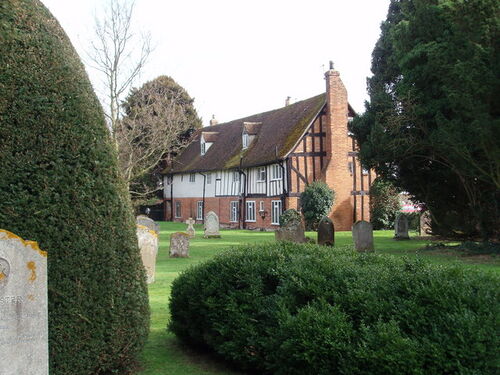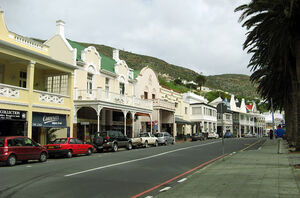Contents |
Biography
Birth and Parentage

|
| [1] |
Levi was born in Kempston,[2] Bedfordshire, England on 31 January 1775. His parentage has yet to be ascertained.
At some point before his marriage, he moved to St Neots, Huntingdonshire. This is the town listed as his home in Pallot's Marriage Index. [3]He is recorded as being a husbandman,[4]a free tenant farmer or small landowner. [5]Marriage and Family

|
| [6] |

|
| [8] |
Children of Levi and Sarah Maynard
| Full Name | Profile | Birth date | Place of Birth | Citation | Death date | Place | Citation |
|---|---|---|---|---|---|---|---|
| James Mortimer Maynard | 8 Apr 1800 | Bedfordshire, England | [9] | 9 September 1874 | Wynberg, Western Cape, South Africa | [10] | |
| Joseph Maynard | 9 Jun 1802 | Bedfordshire, England | [11] | 12 Apr 1876 | Wynberg, Western Cape, South Africa | [11] | |
| Leah Maynard | Jan 1805 | Bedfordshire, England | [12] | 21 Aug 1898 | Mortimer Hall, Wynberg, Cape Town, Cape Province, South Africa | [12] | |
| Mary Ann Maynard | 24 Dec 1809 | Westminster, London, England | [13] | 14 May 1876 | Wynberg, Western Cape, South Africa | [13] |
After the end of the Napoleonic Wars in 1815, an economic depression seized Britain and the United States. In England and Wales, an agricultural depression resulted in the Corn Laws being passed which put pressure on the system of poor relief inherited from Elizabethan times, after Henry VIII had dismantled the Catholic Church's system.[14]
For a short time, there was also a surge in textile manufacture in England, followed by periods of chronic industrial economic depression, especially among textile weavers and spinners, mainly in Lancashire. Industrialists, cutting wages without offering relief, blamed market forces generated by the aftershocks of the Napoleonic Wars.
The Corn Laws slapped a tariff on foreign grain to try to protect English agricultural landowners. Food prices for the working class rose since people had to buy pricier, lower quality British grain, and periods of famine and chronic unemployment resulted, increasing the desire for political reform.[15]
In Ireland, the depression caused wheat and other grain prices to half. As population growth increased, landlords converted cropland into rangeland by passing laws to evict tenant farmers in 1816, which in turn, led to the remaining land plots being subdivided under tillage and less efficient, less profitable subsistence farms. In Scotland, the depression ended in 1822. [16]
In an attempt to solve the problem of high unemployment in the country, the British Government decided to
- try an experiment on a small scale, how far it might be possible to employ the surplus population of this country in one of our colonies in such a manner as might be advantageous to the people removed and beneficial to the country. From the satisfactory result of this experiment it was that the Government were now desirous of trying the experiment on a larger scale. The Colony selected was that of the Cape of Good Hope....Her Majesty's Government,...had selected the Cape of Good Hope as the Colony to which emigration might be most advantageously directed.

|
| Simon's Bay - Naval Base 1806 [17] |
- From the mildness of the climate, and the fertility of the soil in some parts, a rapid and abundant return might reasonably be expected. That Colony was also highly favourable to the multiplication of stock. The particular part of the Colony selected was the south-east coast of Africa. It was at some distance from Cape Town. A small town was already built there. It was proposed to pay the expense of the passage, and at the same time to secure to the settler the means of employing his industry to advantage on his landing at the destined spot. But a small advance of money would be required from each settler before embarking, to be repaid him in necessaries at the Cape, by which means, and by the assistance given him by the Government, he would have sufficient to procure him a comfortable subsistence till he got in his crops, which in that climate were of rapid growth. The Cape was suited to most of the productions both of temperate and warm climates, — to the olive, the mulberry, the vine, as well as most sorts of culmiferous and leguminous plants. The persons emigrating to this settlement would soon find themselves comfortable. [18]

|
| [19] |
However, according to a letter which Levi, James Mortimer and Joseph wrote to Hezekiah Sephton, requesting the return of their deposit, they chose not to go with the rest of the party to Algoa Bay, seeing better prospects for themselves at Cape Town, which is where, in Simon's Town, they eventually settled and from whence the letter, dated 29 June 1820 was written.[4]In 1824 Levi moved to Cape Town where he established himself, probably supplying timber to passing ships - he and his sons were sawyers.[4] By this time, there must have been family troubles, because Levi and Sarah separated. Separation papers were drawn up between them, with their sons as trustees for their mother. [4]
Death
Levi passed away in Wynberg, Cape Town, on 23 June 1856. [21]
Maynardville Park is named after his son, James Mortimer Maynard.[22]
Sources
- ↑ Creative Commons license: Kempston, Church End Cottages. Photo by Richard Schmidt. (CC BY-SA 2.0) Retrieved from (Here;) Accessed 25 Nov 2021.
- ↑ eggsa 1820 Settlers., Kempston, Church End Cottages (Here) Accessed 25 Nov 2021.
- ↑ Ancestry.com. England, Pallot's Marriage Index, 1780-1837 [database on-line]. Provo, UT, USA: Ancestry.com Operations Inc, 2001. Original data: The original paper slip index, from which this database was created, is owned by The Institute of Heraldic and Genealogical Studies, Canterbury, England. Retrieved from (Here;) Accessed 25 Nov 2021.
- ↑ 4.0 4.1 4.2 4.3 4.4 4.5 Robinson, E.H., (1996). Beyond the City Limits: People and Property at Wynberg, (1795 -1927). (p.112). Thesis presented for the Degree of PhD, in the Department of History University of Cape Town, December 1995. University of Cape Town (UCT) non-exclusive license granted to UCT by the author. Retrieved from (Here;) Accessed 22 Nov 2021.
- ↑ Wikipedia. Husbandman. Retrieved from Wikipedia (Here;) Accessed 25 Nov 2021.
- ↑ Creative Commons: Stevington, St.Mary the Virgin. Photo by Michael Trolove. (CC BY-SA 2.0) Retrieved from (Here;) Accessed 25 Nov 2021.
- ↑ Sarah Maynard, 30 March 1827, aged 49 & 3 months. Death in The Colonist: Retrieved from Google e-books (Here;) Accessed 22 Nov 2021.
- ↑ From the Free Internet Repository: Wikipedia,"Wesley's Chapel," Retrieved from Wikipedia (Here;) Accessed 25 Nov 2021.
- ↑ James Mortimore Maynard, 1818. England Births and Christenings, 1538-1975. FamilySearch Database. Retrieved from FamilySearch (Here;) 24 Nov 2021 .
- ↑ James Mortimer Maynard, Probate. South Africa, Cape Province, Probate Records of the Master of the High Court, 1834-1989. FamilySearch Online Database with images, (007844938 > image 1977 of 2120; Pietermaritzburg Archives (Formerly Natal State Archives), South Africa.) Retrieved from FamilySearch (Here;) Accessed 24 Nov 2021.
- ↑ 11.0 11.1 Memorial page for Joseph Maynard (9 Jun 1802–12 Apr 1876), Find a Grave, database and images. Find a Grave Memorial ID 156158002, citing St. John's Churchyard, Wynberg, City of Cape Town Metropolitan Municipality, Western Cape, South Africa ; Maintained by Scooter T (contributor 48110330). Find A Grave: Memorial #156158002 Accessed 24 Nov 2021.
- ↑ 12.0 12.1 Leah, 1898. South Africa, Settlers Index, 1820-1920. FamilySearch Online Database. Retrieved from FamilySearch (Here;) Accessed 24 Nov 2021.
- ↑ 13.0 13.1 Maynard Farmer, 1876. South Africa, Settlers Index, 1820-1920. FamilySearch Online Database. Retrieved from FamilySearch (Here;) Accessed 24 Nov 2021.
- ↑ Soil and Health. Agricultural Depression and the Poor Law. Retrieved from Soil and Health [1813-37https://soilandhealth.org/wp-content/uploads/01aglibrary/010136ernle/010136ch15.htm (Here;)] Accessed 25 Nov 2021.
- ↑ Ed. Farrer, William., & Brownbill, J., (1911)., The city and parish of Manchester: Introduction, in A History of the County of Lancaster: (Vol. 4, pp.174-187). London: Victoria County History. Retrieved from British History Online (Here;) Accessed 25 November 2021.
- ↑ Thernstrom, Stephan., (1980)., Harvard Encyclopaedia of American ethnic groups. (p.944)., Cambridge, Mass.: Belknap Press. Retrieved from the Internet Archive (Here;) Accessed 27 Nov 2021.
- ↑ From the Free Internet Repository: Wikipedia. "Simon's Town,"Retrieved from Wikipedia (Here;) Accessed 25 Nov 2021.
- ↑ Campbell, Colin Turing., (1897)., British South Africa; a history of the colony of the Cape of Good Hope, from its conquest 1795 to the settlement of Albany by the British emigration of 1819-- ; with notices of some of the British settlers of 1820, (p.32). London: John Haddon & Co. Retrieved from the Internet Archive (Here;) Accessed 21 Nov 2021.
- ↑ From the Free Internet Repository: Wikipedia "1820 Settlers," Retrieved from Wikipedia (Here;) Accessed 21 Nov 2021.
- ↑ Sarah Mortimer, Levi Maynard, 1820 Settlers. Retrieved from British 1820 Settlers to South Africa (Here;) Accessed 21 Nov 2021.
- ↑ Levi Maynard, 1856 in South Africa, Cape Province, Probate Records of the Master of the High Court, 1834-1989. FamilySearch Online Database with images. Retrieved from FamilySearch (Here;) Accessed 22 Nov 2021.
- ↑ Wikipedia. Maynardville Park, Cape Town. Retrieved from Wikipedia (Here;) James Mortimer Maynard. Retrieved from Wikipedia (Here;) Accessed 25 Nov 2021.
Maynardville Park: https://en.wikipedia.org/wiki/Maynardville_Open-Air_Theatre
No known carriers of Levi's DNA have taken a DNA test.
Have you taken a DNA test? If so, login to add it. If not, see our friends at Ancestry DNA.
Levi is 27 degrees from Emeril Lagasse, 21 degrees from Nigella Lawson, 20 degrees from Maggie Beer, 45 degrees from Mary Hunnings, 29 degrees from Joop Braakhekke, 30 degrees from Michael Chow, 27 degrees from Ree Drummond, 24 degrees from Paul Hollywood, 25 degrees from Matty Matheson, 26 degrees from Martha Stewart, 35 degrees from Danny Trejo and 35 degrees from Molly Yeh on our single family tree. Login to find your connection.
Categories: 1820 Settlers to South Africa | Cape Town, Cape Colony






Thanks,
Arthur.....
https://www.facebook.com/ArthurCWaddell/
https://www.familytreedna.com/groups/maynard-north-carolina/